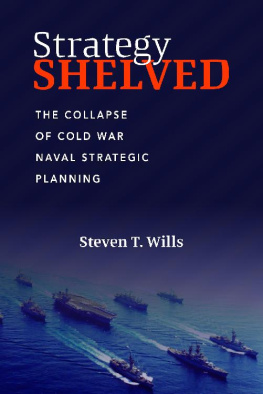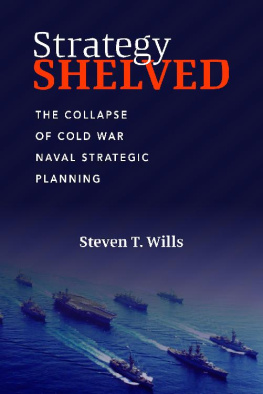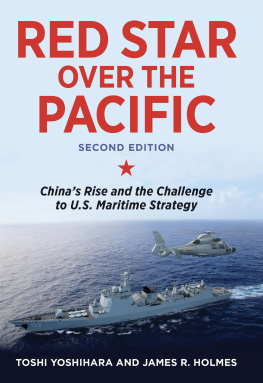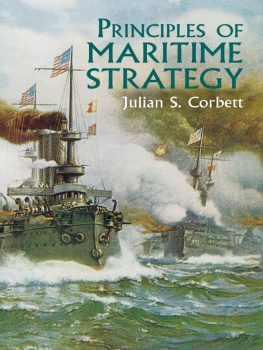

Naval Institute Press
291 Wood Road
Annapolis, MD 21402
2015 by Peter D. Haynes
All rights reserved. No part of this book may be reproduced or utilized in any form or by any means, electronic or mechanical, including photocopying and recording, or by any information storage and retrieval system, without permission in writing from the publisher.
Library of Congress Cataloging-in-Publication Data
Haynes, Peter D.
Toward a new maritime strategy: American naval thinking in the postCold War era / Peter D. Haynes.
1 online resource.
Includes bibliographical references and index.
Description based on print version record and CIP data provided by publisher; resource not viewed.
ISBN 978-1-61251-864-0 (epub) 1. Naval strategyHistory20th century. 2. Naval strategyHistory21st century. 3. United States. NavyHistory. 4. Sea-powerUnited StatesHistory. 5. Military doctrineUnited StatesHistory. I. Title.
V165
359.030973dc23
2015019884

 Print editions meet the requirements of ANSI/NISO z39.48-1992
Print editions meet the requirements of ANSI/NISO z39.48-1992
(Permanence of Paper).
23 22 21 20 19 18 17 16 15 9 8 7 6 5 4 3 2 1
First printing
To my lovely wife, Monica
Contents
F irst and foremost, I would like to thank my beautiful wife, Monica, the love of my life, for her overwhelming support and love, and our two children, Dallan and Brietta, for their support, love, patience, and humor. They are the center of my world, and the long journey of writing the book would not have been completed without their infinite encouragement. I would like to thank Mom and Dad for being great parents and role models, and Mo for having been a wonderful mother-in-law. I am truly blessed to have such a wonderful family. I would like to thank Dan Moran, a gentleman and scholar of endearing brilliance and patience, for his insights and hard work, and Jim Wirtz for his advice and enthusiasm. I am indebted to Dan and Jim for their support and friendship, and to other professors at the Naval Postgraduate School, particularly David Yost, Anne Clunan, and Jeff Kline. I take great pleasure in thanking Peter Swartz, a former Navy strategist and an analyst at the Center for Naval Analyses, for his insights, friendship, and ever-present support, as well as his dedication to maintain the flame of strategic thinking in the Navy. I am beholden to Randy Papadopoulos, Tom Hone, Paul Nagy, and the Naval History and Heritage Command for their encouragement, as well. Finally, I want to thank the U.S. Naval Institute for its leadership and support, and for the institutes warm and professional folks that I have been privileged to work with, particularly Tom Cutler, Gary Thompson, Emily Bakely, and Claire Noble. During the writing of this book, I have drawn strength from my faith in God, my family, my friends, the United States, and the U.S. Navy. The Navy is an institution that is woven into the fabric of my life and that of my family, one that I am privileged and honored to be a part of.
I n October 2007 the U.S. Navy released A Cooperative Strategy for 21st Century Seapower, a strategy that represented a fundamental shift in the Navys strategic outlook. This is not a recapitulation of a rhetorical claim, familiar since the founding of the Republic, that Americas interests are humankinds interests: it is, essentially, the opposite of that claim.
This international economic and political system is the source from which the United States draws most of its power, influence, and ability to provide for and defend its way of life, the homeland, and the system itself. The system is the wellspring of U.S. power, which should not be surprising as it was designed by the United States as such. The institutions, regimes, and practices of this system, many of whichsuch as the Bretton Woods accordswere developed by the United States and its key allies during and shortly after World War II, were designed to privilege U.S. interests and those of its key security and economic partners. By controlling the international monetary and financial structures it designed into the system and providing a nuclear umbrella to its trading partners, the United States fashioned itself into a systemic leader and manager of a highly successful political and economic order that came to be called the free world. The United States engineered the rise of its order in war-torn Europe and Japan and the downfall of imperialism worldwide. In managing the system with and on behalf of others as well as on behalf of its own interests, the United States established a viable alternative to the Soviets vision of European modernity. In practical terms, then, we might describe this system more accurately as the U.S. liberal political and economic system.
With its A Cooperative Strategy, the Navy argued that the U.S. Navy, Marine Corps, and Coast Guardthe nations maritime serviceshave a uniquely preeminent role in protecting the system and sustaining the United States leadership of that system. By being deployed around the globe to manage crises, prevent conflict, and deter large-scale war, these maritime services underwrite the political, commercial, and security conditions necessary for global prosperity. In part because they operate in international waters, they knit broader interests with like-minded states in ways that air forces and armies cannot. Since world trade is essentially maritime trade, any compromise of the United States ability to secure the freedom of the seasand specifically to ensure the flow of petroleumthreatens the prosperity of the United States, its allies, and its trading partners, all of whom, regardless of rivalries, share a common interest in systemic prosperity, growth, and stability. By advancing a cooperative systemic strategy, one that takes full account of the strategic importance of wealth accumulation and distribution, the Navy acknowledged that its own strategic outlook, and by implication that of the United States, was too militaristic and threat-centric, that it was focused too much on the requirements of operations and warfighting at the expense of thinking about strategic requirements. By advancing such a strategy, the Navy acknowledged that the U.S. maritime services and the United States could no longer afford to separate military goals from economic and political goals.
Ironically, the Navy might have developed A Cooperative Strategy at any time since World War II and most certainly since the collapse of the Soviet Union. If one were to take a copy of A Cooperative Strategy and replace the word global with free world or NATO, and otherwise read it in the context of Cold War geopolitics, one might reasonably come away with the impression The Cold War was fundamentally a struggle between two anticolonial great powers striving to prove the efficacy of their respective systemic models. Only one of these modelsthe free worldsdelivered unprecedented increases in the standards of living, met societal expectations, and made up for its political leaders miscues. Among the reasons why the United States won the Cold War was that nearly all the worlds richest states ended up on its side linked by a robust network of trade that was connected and sustained by American sea power. In the final analysis, the strength of the U.S. system proved more instrumental in ending the war than any explicit U.S. military strategy.
After the Cold War the free world expanded into the globalized world, thereby expanding Americas responsibilities as well. At this point, one might have expected that the Navyno longer burdened with having to prepare for great-power warwould redefine its purpose in systemic versus threat-based warfighting terms and restructure the fleet accordingly, focusing on developing platforms more for its constabulary and diplomatic roles and less for its warfighting role. Given its unique relationship to the United States state-market relationship, no other U.S. military service was more suited to invoke and extend a systemic history of the Cold War (and its role therein) as a basis for a more systemic vision of U.S. postwar strategy. The Cold War had, ostensibly, validated the relationship between global naval power, economic globalization, and liberal political integration. The United States role as systemic manager had not changed, nor had its geostrategic position astride the trade routes of Europe and Asia, a reminder that sea power is not just about warships.
Next page










